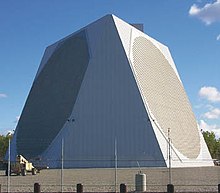Ballistic Missile Early Warning System

The United States Air Force Ballistic Missile Early Warning System (BMEWS) was the first operational ballistic missile detection radar. The original system was built in 1959 and could provide long-range warning of a ballistic missile attack over the polar region of the northern hemisphere. They also provided satellite tracking data. The three installations are:
- Site I- A United States Air Force facility at Thule Air Base, Greenland,
(76°34′08″N 68°19′05″W / 76.569°N 68.318°W) operated by the 12th Space Warning Squadron.[1] - Site II - A second USAF facility at Clear Air Force Station, Alaska,
(64°17′19″N 149°11′22″W / 64.28861°N 149.18944°W) [2] - Site III - A Royal Air Force facility of Fylingdales, in the United Kingdom
(54°21′42″N 0°40′11″W / 54.3616°N 0.6697°W)
The three facilities operated their original 1950s vintage radars for more than four decades, but all have been upgraded with more modern phased array radars. The facility at Clear Air Force Station was the last to be upgraded, and now operates a PAVE PAWS radar that was moved from Texas in 2001.[3] Information received from the BMEWS radars is forwarded to Cheyenne Mountain Air Station, Colorado where it is coordinated with data from other sensors, including other Pave PAWS sites.
Operations


The original sites used two types of radars, the UHF range/425 MHz AN/FPS-50, with four (at Site 1) or three (at Site 2) fence antennas for initial detection, each 165 feet (50 m) tall and 400 feet (120 m) wide, and UHF range/425 MHz AN/FPS-49, later upgraded to AN/FPS-92, fully steerable tracking dish, 85 feet (26 m) in diameter, installed in a large radome. One fence antenna covered a 40 degree sector of the horizon, for a total site coverage of 120 degrees. A prototype of BMEWS, located in Trinidad, began providing surveillance and tracking of ballistic missiles by 1958, and went operational on February 4, 1959, to gather data on missiles fired at the Atlantic Missile Range, as well as satellites and meteors. The full BMEWS radar network became operational in the early 1960s. Each site had dual IBM 7094 computers for signal processing and impact prediction.
The Soviet Union developed a Fractional Orbital Bombardment System (FOBS) in part to counteract the network of sensors covering the northern hemisphere, including BMEWS, which was only able to point in a fixed direction. FOBS placed a warhead in low earth orbit, reducing the line-of-site ranges tremendously compared to the traditional "lofted" trajectories of a conventional ICBM. Additionally, the FOBS could be launched southward, overflying most of the globe and then approaching the US from the south, where it would be invisible to BMEWS. Submarine-launched ballistic missiles also avoided detection by BMEWS, developing into a credible threat in the 1970s. The Defense Support Program (DSP) early warning satellites were developed in part to counter this threat, detecting the infrared "bloom" from the launch rockets no matter where they occurred.
Moon alarm
On October 5, 1960, the moonrise occurred directly in the path of the Thule detection radar, producing a strong signal return. While the computer system never generated an impact prediction, the large amount of data caused enough concern that the equipment was subsequently modified to reject moon returns based on their long (2 second) delay.
Upgrades

The Thule and Fylingdales sites were upgraded with phased array radars in the 1990s. BMEWS 3, located in RAF Fylingdales, was upgraded by Raytheon/Cossor AeroSpace and Control Data Corporation at a cost of US $100M. The new antenna was a 3 faced phased array antenna providing 360 degrees of coverage. The embedded computer was a CDC-Cyber running JOVIAL. The Clear, Alaska site was upgraded in 2001 with a PAVE PAWS radar that was originally located at Eldorado Air Station, Texas. The phased array radars operate in the 420-450 MHz (UHF) frequency range.
Along with the PAVE PAWS radar sites at Cape Cod Air Force Station on Cape Cod, Massachusetts41°45′09″N 70°32′19″W / 41.7524°N 70.5386°W, Beale Air Force Base, California39°08′10″N 121°21′02″W / 39.1361°N 121.3506°W and the PARCS radar at Cavalier AFS, North Dakota48°43′29″N 97°53′59″W / 48.7246°N 97.8998°W, the BMEWS sites provide continual ground-based missile warning for the United States and Canada, with satellite surveillance as a secondary role.[2]
See also

- Nuclear weapons and the United States
- PAVE PAWS
- Globus II
- Missile Defense Alarm System
- Defense Support Program
- Specific US radar and locations
References
- ^ Thule AB, Greenland
- ^ a b Clear AFS Mission See alternate Clear AFS site
- ^ Pave PAWS System
- Alternate Clear AFS, See Global's Clear AFS
External links
- Historic American Engineering Record (Library of Congress) (HAER AK-30-A) - Clear Air Force Station, Ballistic Missile Early Warning System Site II
- A detailed personal account of BMEWS
- Global's Space Systems information with pictures
- BMEWS Program overview from 1997
